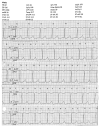A Case of Severe QTc Prolongation During Targeted Temperature Management - What Can We Learn?
- PMID: 32839424
- PMCID: PMC7476741
- DOI: 10.12659/AJCR.924844
A Case of Severe QTc Prolongation During Targeted Temperature Management - What Can We Learn?
Abstract
BACKGROUND QTc prolongation during targeted temperature management (TTM) post cardiac arrest is a known effect of hypothermia, but its significance is unclear. Several studies suggest that temporary prolongation during TTM is not prognostic and does not potentiate fatal arrhythmias; however, there are limited cases of patients presenting with QTc intervals >700 milliseconds. CASE REPORT We describe a case in which a 57-year-old woman with diabetes, hypertension, and atrial fibrillation presented with concern for stroke. The hospital course was complicated by cardiac arrest requiring TTM, which was stopped early due to significant QTc prolongation of 746 milliseconds. CONCLUSIONS TTM is beneficial post resuscitation for good neurological outcomes, but it also has known adverse cardiac effects such as QTc prolongation. The significance of QTc prolongation during TTM is unclear as several studies have shown no increased incidence of malignant arrhythmias. One case report in the literature describes the incidence of torsades de pointes due to QTc prolongation during TTM. Further study and guidelines regarding electrocardiogram monitoring are needed to determine the importance of QTc prolongation during TTM.
Conflict of interest statement
None.
Figures





References
-
- Huang CH, Tsai MS, Hsu CY, Chen WJ. Images in cardiovascular medicine. Therapeutic hypothermia-related torsade de pointes. Circulation. 2006;114(14):e521–22. - PubMed
-
- Khan JN, Prasad N, Glancy JM. QTc prolongation during therapeutic hypothermia: Are we giving it the attention it deserves? Europace. 2010;12:266–70. - PubMed
-
- Storm C, Hasper D, Nee J, et al. Severe QTc prolongation under mild hypothermia treatment and incidence of arrhythmias after cardiac arrest – a prospective study in 34 survivors with continuous Holter ECG. Resuscitation. 2011;82(7):859–62. - PubMed
-
- Rosol Z, Miranda DF, Sandoval Y, et al. The effect of targeted temperature management on QT and corrected QT intervals in patients with cardiac arrest. J Crit Care. 2017;39:182–84. - PubMed
Publication types
MeSH terms
LinkOut - more resources
Full Text Sources

